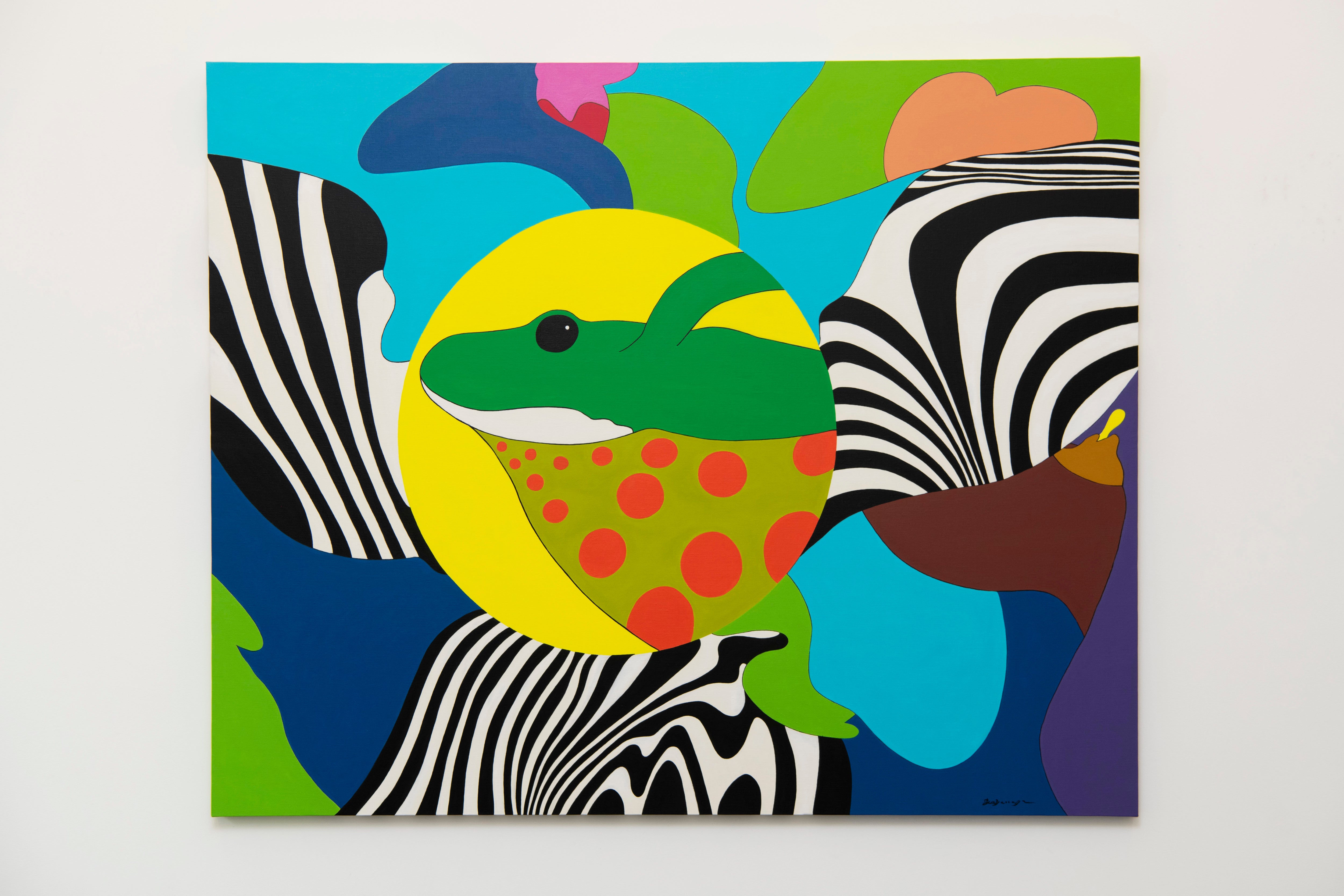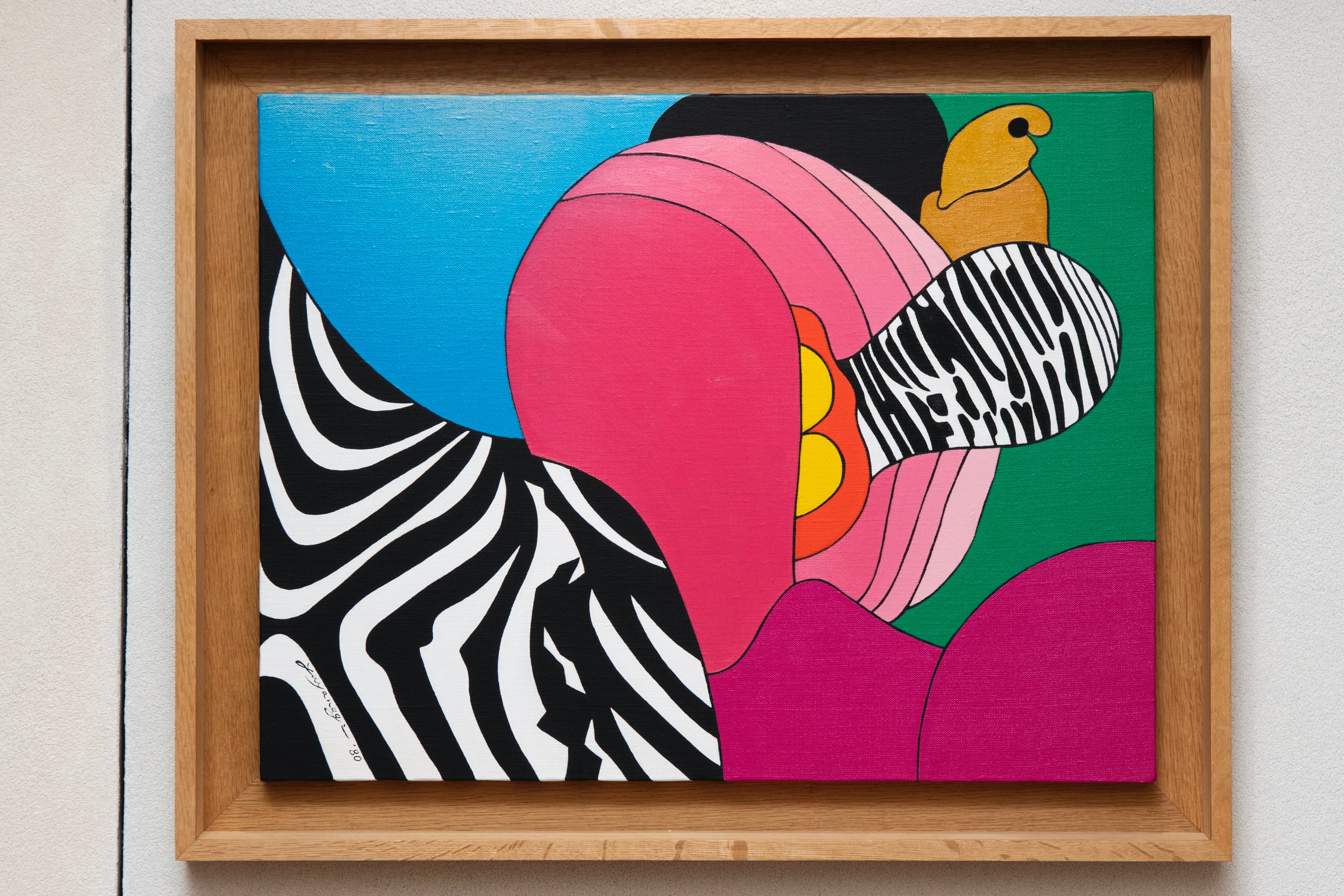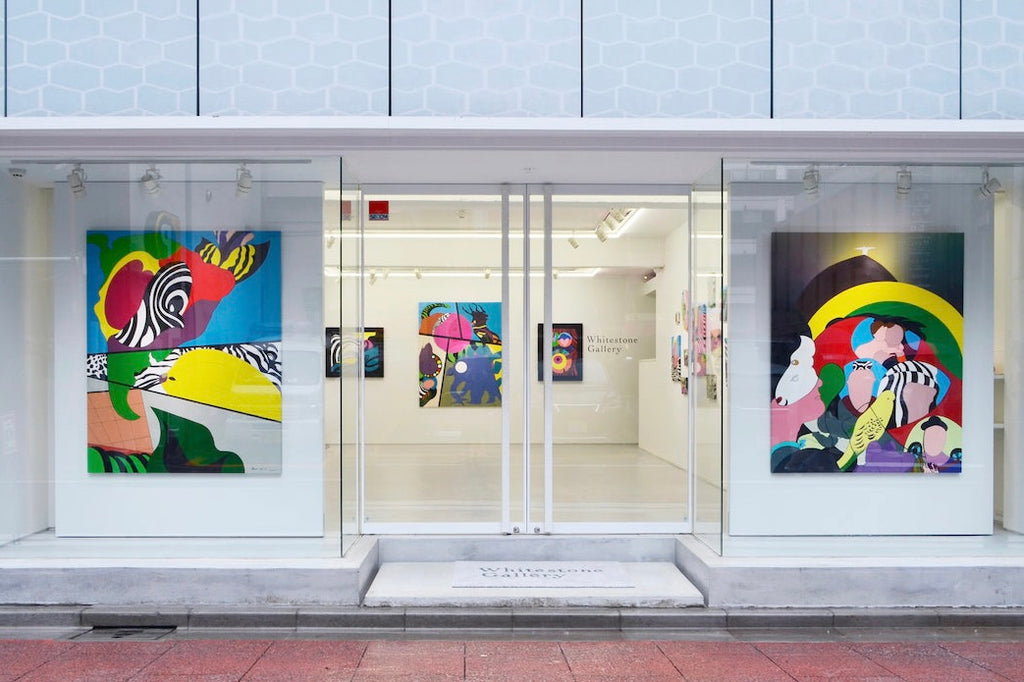ARTICLES
Interview with Artist Go Yayanagi | "Hop Step Jump" Solo Exhibition
June 27, 2022
Tokyo, Japan

How Go Yayanagi became an Artist

Go Yayanagi's solo exhibition "Hop Step Jump" installation view
Go Yayanagi recalls his beginnings as an artist as if it was a story that happened agesago. He was supposed to inherit his family's horse ranch in Hokkaido, but while studying at a university in Tokyo, he encountered a masterpiece of a painting that would set him on a path to become an artist.
Yayanagi:I was born in the Tokachi region of Hokkaido. I moved to Tokyo to study in the Hoshi University in Gotanda. One Sunday during my junior year, I decided to visit an art museum. They were holding a grand exhibition that featured the works of Vincent van Gogh (1853-1890) for the first time in Japan. Upon seeing it, I was quite surprised at how art seemed to unlock a person's inner spirit. Van Gogh's spiritual essence where he paints swirling colors around the cypress trees blew me away. This made me realize how wonderful art can be.
I was majoring in physics at the time, but I realized that I was not really suited to that field of study, so I decided to live my whole life in the world of art.
Back then, I was still young, impressionable, and passionate. So I decided to drop out of university and enter the world of painting. At first, I had to learn everything by myself, and I imagined myself being just like Van Gogh. I sometimes went to the Naguri River in Hanno, Saitama Prefecture with a canvas on my back, and I would wait for dawn until the sunrose to paint. That was the story of my youth.

Go Yayanagi’s exhibition main visual image artwork, "Dream Frog. Spring Has Come!" (2022)
Yayanagi was just a year away from graduating, and he went to study in Tokyo on the condition of returning to inherit the family ranch after graduation. Naturally, his father was strongly opposed to his decision to become an artist. But despite being accused of being unfilial, Yayanagi decided to stay on the path of art.
Yayanagi: Art is something that cuts into your whole life. Artistic expression is a world that cannot be seen. But turning that hidden meaning into something creative is something I find interesting.
A Lone Trip to Brazil, Beginning Life as an Artist

Go Yayanagi's early paintings from the 1960s displayed at the exhibition
Yayanagi: When I was 20 years old, I decided to go to Brazil. I boarded the Brazil Maru immigrant ship from Yokohama, and it passed through the Panama Canal before arriving in Sao Paulo in Brazil, taking a total of 49 days.
Back then, people who wanted to study contemporary art or learn new painting styles usually went to New York, just like On Kawara. Another common choice was Paris because of its rich tradition, and this was where young Japanese artists like Kumi Sugai, Yasukazu Tabuchi, and Hisao Domoto went to study.
As for myself, I decided to go to Brazil partly because I had relatives who immigrated there, but the main reason was because I wanted to visit a country on the opposite side of the world, not for its art scene, but just to see how the world works. At the time, I was also studying archaeology on my own, and I was quite interested in ancient civilizations like the Greeks, the Incas, and the Mayans. That was why I chose to go to Brazil.
When I arrived in Brazil, the first thing that surprised me was seeing the mouth of the Amazon River. It was more like a sea than a river (laughing). I thought to myself how it should be called the Amazon Sea instead. Another thing was the color of its water. It was not blue, but deep yellow. So there I was, awestruck by the power of nature, and surprised at its vastness and grandeur.
Yayanagi still vividly recalls the scenes he saw back then, as if it was occurring right before his eyes. After spending three fulfilling years in Brazil, he then visited Africa, Singapore, the Philippines, and Hong Kong, before returning to Tokyo. After falling ill for around five years, he finally decided to go to Europe.
Yayanagi: After experiencing a new world in Brazil, I set my sights on Europe, and I decided to go to Paris. I boarded the Baikal passenger ship at Yokohama, and after arriving at Khabarovsk, I took the Trans-Siberian Railway to Moscow, then passed through Ukraine, Poland, and East Berlin, before finally arriving in Paris, where I would study for the next three years.
The Difference Between Western and Japanese Art

Go Yayanagi's works from 2017 onwards, displayed in the exhibition
Yayanagi spent three years in Brazil and three years in France, with visits to various countries in Africa and Southeast Asia in between. He also exhibited his works at many international exhibitions, including the 11th São Paulo Biennial (1957) and the 2nd Frechen International Exhibition of Print Art in West Germany (1972). We asked him what he learned from his activities overseas.
Yayanagi: In Western art, the entire space is usually filled. It has a certain viscosity. They often use oil paints, which inherently exhibits those qualities.
From a personal point of view, I think Western art is a carnivorous culture, while Japanese art is an herbivorous culture. After studying in Europe for three years, I realized that most Japanese are herbivores. And I thought that I should avoid imitating the style of Western art.
I want to clearly define my own identity. It doesn't matter if you're good or bad at painting. I learned that in art, you need to have strong roots and a good grasp of theory, and you need to lead your own life.
Furthermore, every country has its own culture and history, and a certain mentality towards the ever-changing times. Since I am Japanese, I thought that I should thoroughly learn the traditions of Japan. If you don't study your own country's traditions, you cannot bring about innovation. Which is why I decided to study all about traditional Japanese art.

Go Yayanagi's "Germination" (1980) in the exhibition
After studying for three years in Paris and experiencing the difference in Western art and culture, Yayanagi turned his attention to the culture of his motherland, studying works such as the Choju-Giga (Frolicking Animals), which is said to be the very first manga of Japan.
Yayanagi:Manga is currently experiencing a boom, but it was pioneered by the Japanese long ago with the Choju-Giga. That's an amazing thing. Through the following decades, it was diversified by artists like Ito Jakuchu, Ogata Korin, and Hokusai. Personally, I think Hokusai is a genius even greater than Picasso.
Japanese literature is also marvelous. I studied the classics like the Tale of Genji and the Kojiki, and I've even expressed them in my paintings. There was one time during an overseas exhibition, a Chinese person asked me, "Your paintings are interesting and full of humor. Where do you get your humor from?" The young man kept on asking me such questions. And when I asked him "What is humor?" and explained about traditional Japanese culture, he finally seemed to understand. From his perspective, my paintings appeared to have something that make people chuckle.
That is the way art can cross language barriers and national boundaries, and break free from the shackles of the world. And I got to enjoy those kinds of opportunities from working overseas.

The "GO YAYANAGI: POP UKI" exhibition at the Whitestone Gallery Taipei
After taking a deep interest in traditional Japanese art, Yayanagi started making use of a style he calls "Pop-Uki" in his paintings and sculptures from the 1960s onwards. Pop-Uki is a portmanteau of "pop art" and "ukiyo-e" (woodblock prints), and it captures Yayanagi's characteristic style of clean and crisp lines and bright colors.
"Road Art" ー Accessible Art Through Fashion

The exhibition floor featuring Yayanagi's "Earth, Air, Environment" (2000-2022) painted on a coat
While making art is his main profession, Yayanagi's activities are wide-ranging, and include working with fashion designers, creating murals, designing stained glass, and more. He has particularly deep ties with fashion, having held many collaborative exhibitions overseas together with the world-famous fashion designer Junko Koshino. His involvement with fashion comes from his desire to make art that is accessible and enjoyable for everyone. Yayanagi calls this kind of art "road art".
Yayanagi: I take pride in being the very first artist in Japan to do collaborative work with fashion. Art and fashion are fundamentally different fields. Humans used to live without clothing, but now everyone wears them. So I thought of clothing as skin, and I tried drawing on a large piece of textile and using it to make a print.
The American art collector Norman H. Tolman, whose collection includes my paintings, once told me that it would be interesting to see my paintings as fashion items, so he introduced me to the famous Japanese fashion designer Jun Ashida, who owned a shop in Ginza. I worked with Jun Ashida to create some extravagant fashion items, and they received wide acclaim when he presented them at the Paris Fashion Week. The items became quite popular after being worn by a famous Japanese actress.
Before I knew it, the art that I had been making under the concept of "road art" had become an item of collaboration with the fashion industry. However, Japanese society tends to be rather conservative and old-fashioned, so back then, there weren't many artists who took the unconventional approach of collaborating with fashion, and those who did so were largely ignored.

Items designed with Go Yayanagi's artworks in the exhibition
I'm also not very fond of creating artistic expression as a group, so I have always been a lone wolf for over 70 years. I tried to avoid such things in order to express myself freely. This is why many art critics have told me that my art is too inaccessible (laughing). They suggested to me to make art that even the media can understand. But I don't feel the need to indulge my audience. In the world of art, it is important to be able to express yourself freely. That has always been my adamant policy even today.
Thoughts on the Pandemic and Effects on Work

Even at 89 years old, Go Yayanagi still continues to make art every day
It has been over 70 years since Yayanagi aspired to become an artist during his junior year at university. We asked him his thoughts about the crises facing the world today, such as the COVID-19 pandemic and the Russian invasion of Ukraine.
Yayanagi:I secluded myself for nearly three years. With regards to the coronavirus, I obtained information in my own way, sometimes receiving information through phone calls from friends and artists around the world.
I talked to other artists like Takesada Matsutani who lives in Paris. I told them that right now, the world is facing many challenges like the pandemic and the war in Ukraine, but we will all lose as artists if we stop painting, so we should all strive to continue making art.
The Bulgarian-born artist Christo (Christo Vladimirov Javacheff, 1935-2020), who recently passed away, also sent me many letters. He always told me not to surrender to the pandemic, and that he wanted to cover the Eiffel Tower with a tent for his next project. He also wrote that he wanted to make massive sculpture made out of oil barrels in the desert of Abu Dhabi.
Just like him, many artists are doing their best to stay positive, thinking about their future projects. I feel the same way myself. That is why I don't think we should close ourselves from the world. Current border restrictions mean that we cannot travel freely, but I think this gives us an opportunity to look at ourselves and think about our future. If you're a salaried worker, you can think about how you can overcome this hardship and make your life better, about what kind of job will make you happy after the pandemic.

Go Yayanagi's works from 2019 to 2022, displayed in the exhibition
The pandemic and the war has greatly affected everyone, including artists. While some artists have already reflected these external factors in their work, Yayanagi chooses to wait quietly for the right time to express such global issues in his artwork.
Yayanagi: Many people have died from the pandemic, and there is an ongoing war in Ukraine. But I am not thinking of expressing these issues in my paintings just yet. It's like when the atomic bomb was dropped on Japan. I cannot immediately express that in my work under that kind of situation after the bombing.
But as I think about these things, it's possible that they will appear in my work. These kinds of things are always in my mind. I'm always thinking about how and where I should express them. The Great East Japan Earthquake is another thing that is always in my mind, but I actually haven't expressed it in my work yet, though I've already done many sketches. When these things will actually appear in my work is something that I will decide while considering my current place in the world.

Go Yayanagi's solo exhibition "Hop Step Jump" installation view
After seeing the masterpiece of a maestro back in his college years, Go Yayanagi decided to enter the world of art. Over 70 years since that time, he dedicated his lively hood in art. In the next part of the interview, we unravel his thoughts on his "Hop Step Jump" solo exhibition that can be considered the culmination of his career, and reveals what he considers imperative as an artist.
Click for more details »
